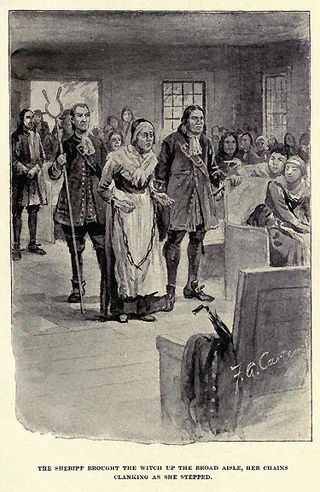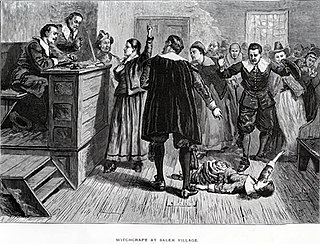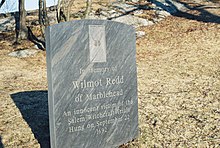
The Salem witch trials were a series of hearings and prosecutions of people accused of witchcraft in colonial Massachusetts between February 1692 and May 1693. More than 200 people were accused. Thirty people were found guilty, nineteen of whom were executed by hanging. One other man, Giles Corey, died under torture after refusing to enter a plea, and at least five people died in jail.
John Proctor, Jr. was a landowner in the Massachusetts Bay Colony. He was the son of John Proctor Sr. (1594–1672) and Martha Harper (1607–1667). John and his 3rd wife were tried on August 5, 1692. He was hanged on August 19, 1692 in Salem Village, Massachusetts Bay Colony during the Salem Witch Trials after being falsely accused and convicted of witchcraft.

John Hale was the Puritan pastor of Beverly, Massachusetts, and took part in the Salem witch trials in 1692. He was one of the most prominent and influential ministers associated with the witch trials, being noted as having initially supported the trials and then changing his mind and publishing a critique of them.

Martha Corey was accused and convicted of witchcraft during the Salem witch trials, on September 9, 1692, and was hanged on September 22, 1692. Her second husband, Giles Corey, was also accused and killed.
Sarah Osborne (also variously spelled Osbourne, Osburne, or Osborn; née Warren, formerly Prince, was a colonist in the Massachusetts Bay colony and one of the first women to be accused of witchcraft in the Salem witch trials of 1692. Sarah Osborn was suggested to be a witch by Sarah Good. Sarah Good said she had been tormenting the girls.

Susannah Martin was one of fourteen women executed for the suspicion of practicing witchcraft during the Salem witch trials of colonial Massachusetts.

Rebecca Nurse was a woman who was accused of witchcraft and executed by hanging in New England during the Salem Witch Trials of 1692. She was fully exonerated fewer than twenty years later.
This timeline of the Salem witch trials is a quick overview of the events.
Mary Towne Eastey was a defendant in the Salem witch trials in colonial Massachusetts. She was executed by hanging in Salem in 1692.
Rev. Nicholas Noyes II was a colonial minister during the time of the Salem witch trials. He was the second minister, called the "Teacher", to Rev. John Higginson. During the Salem witch trials, Rev. Noyes served as the official minister of the trials.
Alice Parker, a resident of Salem Town, Massachusetts, was executed on September 22, 1692, during the Salem Witch Trials.
Mary Bradbury was tried, convicted and sentenced to hang as a witch in Salem, Massachusetts in 1692. However, she managed to avoid her sentence until the trials had been discredited, and died in 1700, aged 85.
Elizabeth Howe was one of the accused in the Salem witch trials. She was found guilty and executed on July 19, 1692.

Samuel Wardwell was a man accused of witchcraft during the Salem witch trials of 1692. He was executed by hanging on September 22, 1692, along with Alice Parker, Martha Corey, Mary Eastey, Ann Pudeator, Mary Parker, Wilmot Redd, and Margaret Scott.

Old Burial Hill is a historic cemetery in Marblehead, Massachusetts. It is located on the high ground between Marblehead's colonial-era residential and retail district, called "Downtown" by longtime residents and "Old Town" by others, and the Barnegat neighborhood that stretches from Little Harbor to Doliber's Cove, and is accessible via a walkway at Redd's Pond and a stairway at the intersection of Orne and Pond streets. It was the location of Marblehead's First Meeting House built around 1638. Old Burial Hill features scenic vistas of Marblehead Harbor and Salem Sound.

Elizabeth Booth was born in 1674 and was one of the accusers in the Salem Witch Trials. She grew up in Salem, Massachusetts, as the second eldest of ten children. When she was sixteen she was accused of being a witch. When she was eighteen, she began accusing people of practicing witchcraft, including John Proctor, Elizabeth Proctor, Sarah Proctor, William Proctor, Benjamin Proctor, Woody Proctor, Giles Corey, Martha Corey, Job Tookey, and Wilmont Redd. Five of these people were executed due to Booth's testimony. Elizabeth Proctor would have been executed as well if she was not pregnant. After the Witch Trials, Booth married Israel Shaw on December 26, 1695, and had two children named Israel and Susanna. Booth's death date is unknown.
Redd's Pond is a pond located in Marblehead, Massachusetts. It was named after Wilmot Redd.

Margaret Scott was found guilty of witchcraft during the Salem witch trials and was executed by hanging on September 22, 1692. She was part of the last group to be executed, which also included Mary Eastey, Martha Corey, Ann Pudeator, Samuel Wardwell, Mary Parker, Alice Parker, and Wilmot Redd. She was the only accused person from Rowley to be executed. As a lower-class, long-term widow, having lost several children in infancy, she was a prototypical witch candidate. When her husband, Benjamin, died, he left a very small estate and she, being unable to remarry, was reduced to begging, which invited resentment and suspicion. In this manner, her circumstances were comparable to fellow victim Sarah Good.

Martha Carrier was a Puritan accused and convicted of being a witch during the 1692 Salem witch trials.










